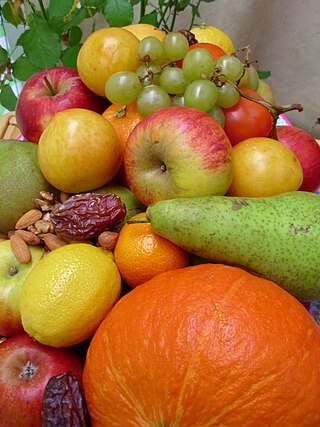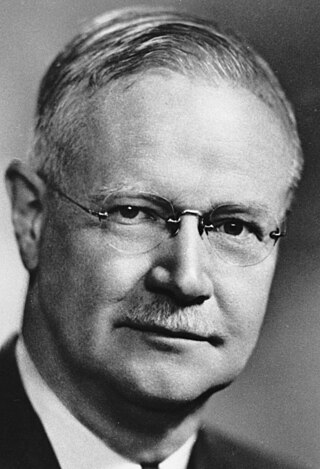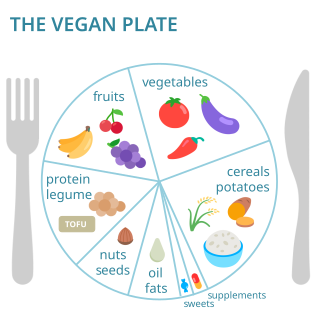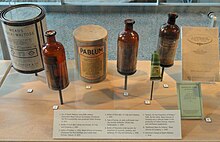
Fruitarianism is a diet that consists primarily of consuming fruits and possibly nuts and seeds, but without any animal products. Fruitarian diets are subject to criticism and health concerns.

Infant formula, also called baby formula, simply formula, baby milk or infant milk, is an ultra-processed food designed and marketed for feeding to babies and infants under 12 months of age, usually prepared for bottle-feeding or cup-feeding from powder or liquid. The U.S. Federal Food, Drug, and Cosmetic Act (FFDCA) defines infant formula as "a food which purports to be or is represented for special dietary use solely as a food for infants by reason of its simulation of human milk or its suitability as a complete or partial substitute for human milk".

Breakfast cereal is a breakfast food made from processed cereal grains. It is traditionally eaten as part of breakfast, or a snack food, primarily in Western societies.

Human nutrition deals with the provision of essential nutrients in food that are necessary to support human life and good health. Poor nutrition is a chronic problem often linked to poverty, food security, or a poor understanding of nutritional requirements. Malnutrition and its consequences are large contributors to deaths, physical deformities, and disabilities worldwide. Good nutrition is necessary for children to grow physically and mentally, and for normal human biological development.

The Hospital for Sick Children (HSC), corporately branded as SickKids, is a major pediatric teaching hospital located on University Avenue in Toronto, Ontario, Canada. Affiliated with the Faculty of Medicine of the University of Toronto, the hospital was ranked the top pediatric hospital in the world by Newsweek in 2021.

Baby food is any soft, easily consumed food other than breastmilk or infant formula that is made specifically for human babies between six months and two years old. The food comes in many varieties and flavors that are purchased ready-made from producers, or it may be table food eaten by the family that has been mashed or otherwise broken down.

Therapeutic foods are foods designed for specific, usually nutritional, therapeutic purposes as a form of dietary supplement. The primary examples of therapeutic foods are used for emergency feeding of malnourished children or to supplement the diets of persons with special nutrition requirements, such as the elderly.

Adelle Davis was an American writer and nutritionist, considered "the most famous nutritionist in the early to mid-20th century." She was an advocate for improved health through better nutrition. She wrote an early textbook on nutrition in 1942, followed by four best-selling books for consumers which praised the value of natural foods and criticized the diet of the average American. Her books sold over 10 million copies and helped shape America's eating habits.
Quality Protein Maize (QPM) is a family of maize varieties. QPM grain contains nearly twice as much lysine and tryptophan, amino acids that are essential for humans and monogastric animals but are limiting amino acids in grains. QPM is a product of conventional plant breeding and an example of biofortification.
Food fortification or enrichment is the process of adding micronutrients to food. It can be carried out by food manufacturers, or by governments as a public health policy which aims to reduce the number of people with dietary deficiencies within a population. The predominant diet within a region can lack particular nutrients due to the local soil or from inherent deficiencies within the staple foods; the addition of micronutrients to staples and condiments can prevent large-scale deficiency diseases in these cases.
Theodore G.H. Drake, MD was a Canadian pediatrician and one of three physicians who developed Pablum.

Cerelac is a brand of instant cereal made by Nestlé. The cereal is promoted for infants 6 months and older as a supplement to breast milk when it is no longer the sole item in an infant's diet. Cerelac is not a substitute for breast milk and it is advised to continue breast feeding or infant formula along with Cerelac. Cerelac can help babies develop tastes for other food as they are weaned from breast milk. It also contains vitamins and minerals like iron, along with essential fatty acids. Cerelac products also contain probiotics that are found in the digestive tracts of breastfed babies. The brand was first registered in 1949 and it is currently sold in Kenya, Tanzania, Belgium, Denmark, Germany, Spain, Portugal, South America, Central America, North America, India, the Middle East, Nigeria, North Africa, Malawi, Nepal, Pakistan, Philippines, Ghana, Ivory Coast, South Africa, South East Asia, United Kingdom, Australia, Zambia and Zimbabwe.

Frederick Fitzgerald Tisdall was one of three Canadian pediatricians who developed the infant cereal Pablum. He first started working at The Hospital for Sick Children in 1921. In 1929, he was made Director of the Nutritional Research Laboratories. In 2013, revelations came to public attention that Tisdall starved Indigenous children for the purposes of experimentation, in direct violation of the Nuremberg Code.

Vegan nutrition refers to the nutritional and human health aspects of vegan diets. A well-planned, balanced vegan diet is suitable to meet all recommendations for nutrients in every stage of human life. Vegan diets tend to be higher in dietary fiber, magnesium, folic acid, vitamin C, vitamin E, and phytochemicals; and lower in calories, saturated fat, iron, cholesterol, long-chain omega-3 fatty acids, vitamin D, calcium, zinc, and vitamin B12.
Infant feeding is the practice of feeding infants. Breast milk provides the best nutrition when compared to infant formula. Infants are usually introduced to solid foods at around four to six months of age.
Malnutrition continues to be a problem in the Republic of South Africa, although it is not as common as in other countries of Sub-Saharan Africa.

Stanley Howard Zlotkin, is a Canadian Professor of Paediatrics, Public Health Sciences and Nutritional Sciences at the University of Toronto.
The First Nations nutrition experiments were a series of experiments run in Canada by Department of Pensions and National Health in the 1940s and 1950s. The experiments were conducted on at least 1,300 Indigenous people across Canada, approximately 1,000 of whom were children. The deaths connected with the experiments have been described as part of Canada's genocide of Indigenous peoples.

A staple food, food staple, or simply staple, is a food that is eaten often and in such quantities that it constitutes a dominant portion of a standard diet for an individual or a population group, supplying a large fraction of energy needs and generally forming a significant proportion of the intake of other nutrients as well. For humans, a staple food of a specific society may be eaten as often as every day or every meal, and most people live on a diet based on just a small variety of food staples. Specific staples vary from place to place, but typically are inexpensive or readily available foods that supply one or more of the macronutrients and micronutrients needed for survival and health: carbohydrates, proteins, fats, minerals, and vitamins. Typical examples include grains, seeds, nuts and root vegetables. Among them, cereals, legumes and tubers account for about 90% of the world's food calorie intake.
Toddler nutrition is the description of the dietary needs of toddlers aged one to two years old. Food provides the energy and nutrients that toddlers need to be healthy. An adequate intake in nutrient rich food is good nutrition. A diet lacking essential calories, minerals, fluid and vitamins could be considered 'bad' nutrition. Nutrition needs are different for toddlers. For a baby, breast milk is "best" and it has all the necessary vitamins and minerals. Toddlers typically have been weaned from breast milk and infant formula. Though infants usually start eating solid foods between 4 and 6 months of age, more and more solid foods are consumed by a growing toddler. If a food introduced one at a time, a potential allergen can be identified. Food provides the energy and nutrients that young children need to be healthy. Toddlers are learning to feed themselves and to eat new foods. They should eat a variety of foods from all the food groups. Each day, toddlers need enough nutrients, including













